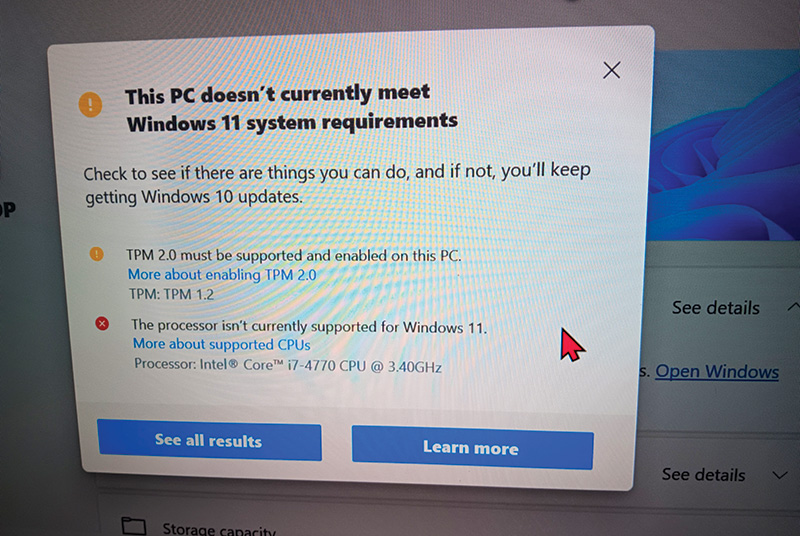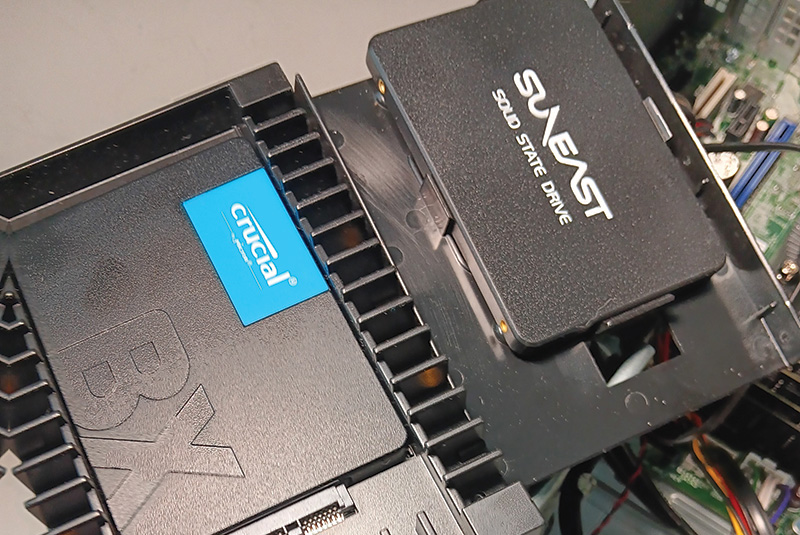
Dire warnings from Microsoft pop up on computers facing the end of security updates for the popular Windows 10 operating system. Photos by Scott Nesbitt
Chances are you’ve seen that email, and you’re among the 40% of PC users who use Windows 10 at work and/or home. Like me. End-of-life day is Oct. 14, 2025. Free Windows 10 security updates stop. Don’t panic. This is not a cash grab or a plot to sell new PCs (this does not apply to Apple/Mac computers).
If some lingo in this article doesn’t jibe, talk with your IT people or favorite geek. I’ll use the term “app” in place of “program” to save space.
Hack attacks are rising in number and strength. Those are all those phishing emails you get with bogus free prizes you’ve won. Don’t click the links.
Hardware called Trusted Platform Module has been in PCs since 2003. Microsoft (MS) says earlier versions aren’t good enough. They favor TPM version 2 (2019 update), paired with Windows 11’s security features (many of which are aimed at big networks, not stand-alone computers).
MS will give you free Windows 11 software. Search the web for “PC Health Check,” and you’ll get to a Microsoft website. Follow the instructions. But you may not qualify. There’s hope.
In late 2024, techie rebels rose against the TPMv2 edict and developed the “Flyby11” free app. Search YouTube for “Effortless Windows 11 Install on ANY PC” to get a plain-language video show-and-tell of how the process works — and the risks.

Both solid state hard drives are rated at 1 TB, but the smaller off-brand hard drive started overheating and failed at an early age. Hardware upgrades make sense as the Oct. 14 deadline for Windows 10 approaches.
Assess how your computers are used. They can’t be hacked if they are not on the internet. Many medical and industrial machines use Windows XP or earlier operating systems. You may be just fine keeping Windows 10, especially if the rebels develop more apps to overcome the hackers.
I use the PC Matic app. It blocks installation of any app not on a “whitelist.” So far, to my knowledge, I’ve not been hacked. I’m careful to read the sender names on all emails. I hover the mouse cursor over any links. Just now I got an email from someone trying to learn our mortgage payoff amount. Weird. I hit delete.
As a pseudo-geek, once paid for PC work, I am prepared for change and watching. Hackers may crack TPMv2. Windows 12 may arise. Rebels may develop apps that change the battlefield entirely.
My Windows 10 is on a 2014 Dell, a fast premium machine that’s still excellent. When it came off lease, someone installed a new 1 TB solid state hard drive and made a profit at a sale price of $180 (including shipping).
I went to a software site I trust, www.majorgeeks.com, and got Belarc Advisor. It gave me four fine-print pages listing all the innards of the computer, with models, versions and serial numbers of all hardware and software. I know what I’m working with.
I got a $60 brand-name 1TB solid state hard drive and free AOMEI disk management software. I used it to make a clone of the failing el-cheapo, which I kept alive by keeping it cool with a small fan. Other free apps I could have used are Acronis, EaseUs or DiskGenius. I took an old 1 TB spinning-disk hard drive and mounted it in a $25 external drive case. I make a fresh clone every Saturday night. It is ready to save me when I return from church on Sunday, having prayed for dispensation from digital disasters. Amen.
Scott R. Nesbitt is a freelance writer and former GCSAA staff member. He lives in Cleveland, Ga.